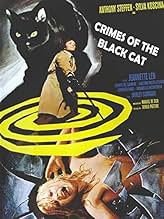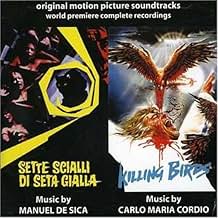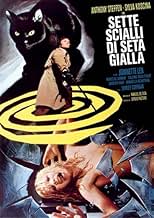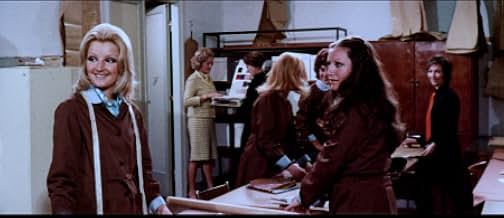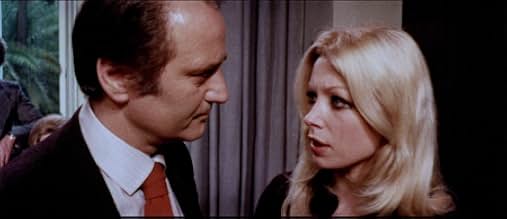IMDb RATING
6.1/10
1.1K
YOUR RATING
A blind pianist overhears a conversation in a nightclub, and is determined to figure out who is responsible for a string of strange murders involving a black cat.A blind pianist overhears a conversation in a nightclub, and is determined to figure out who is responsible for a string of strange murders involving a black cat.A blind pianist overhears a conversation in a nightclub, and is determined to figure out who is responsible for a string of strange murders involving a black cat.
Giovanna Lenzi
- Susan Leclerc
- (as Jeannette Len)
Isabelle Marchall
- Paola Whitney
- (as Isabelle Marchal)
Lorenzo Piani
- Waiter in Hamburg
- (credit only)
Bruno Alias
- Hairdresser
- (uncredited)
Francesco Anniballi
- Male Nurse
- (uncredited)
Florinda Bolkan
- Carol Hammond
- (archive footage)
- (uncredited)
Margherita Horowitz
- Atelier personnel
- (uncredited)
Featured reviews
Following the death of his ex-girlfriend, a film-score composer finds himself and those closest to him in jeopardy when the killers' spree turns to them, forcing him to piece together the strange clues left behind in order to make sense of the mystery and put a stop to the killings.
For the most part, this one proved to be a rather fun giallo. Among the film's best aspects here is the enjoyable storyline that serves the film nicely. There's some fantastic storylines and subplots at aplay, as the initial start with the half-heard conversation and murder the next day at the fashion house launches some fun here with the blackmail revelation, adultery and secret drug-ring that caters to most of the models at their studio, giving the potential for the usual red-herrings and double-crosses throughout the film. The way the connections slowly build together, from the motive of the cat attacking the victims and how the trick was accomplished to the detective work uncovering the real killer detailing all the different incidents that have taken place which is wrapped together for an extremely engrossing, fast-moving mystery. As well, there's quite a lot to like here with the absurd killing method which offers a real change of pace in the genre. The idea of a cat trained to attack using a special poison mis on it's claws being carried around in a wicker basket covered by a yellow shawl is a wholly unique and original tactic that gives the film something different. As the handler still comes with the traditional look and getup, the mix of styles creates some fine shock jumps of the victims suddenly getting attacked by something or the scenes featuring the killer striking in more traditional manners. The stalking scenes are incredibly suspenseful as well, from the train station encounter, the confrontation in the abandoned factory and the incredibly tense finale in the house which has plenty of suspense and graphic kills which give this one a lot to like. There are a few issues with the film. The first problem is a rather distressing inability to really go for its own charge instead of doing the genre's hits like a checklist. This one pulls off every point in the style, from the continuous half-hearted revelations of the blackmailing attempts and secret keeping, the amateur detective following along the nature of the crimes by his inadvertent involvement that comes about through happenstance and the need for continuing on the killing spree in order to keep the secret hidden because the deaths uncovered an unrelated secret. These are all brought about by the needs of the genre and run through here in a generally routine manner, giving it a wholly cliched feel. The other issue is the underwhelming and abrupt finale that is shocking for the suddenness of it's ending, making this one a little lower with these issues.
Rated Unrated/R: Graphic Violence, Full Nudity and Language.
For the most part, this one proved to be a rather fun giallo. Among the film's best aspects here is the enjoyable storyline that serves the film nicely. There's some fantastic storylines and subplots at aplay, as the initial start with the half-heard conversation and murder the next day at the fashion house launches some fun here with the blackmail revelation, adultery and secret drug-ring that caters to most of the models at their studio, giving the potential for the usual red-herrings and double-crosses throughout the film. The way the connections slowly build together, from the motive of the cat attacking the victims and how the trick was accomplished to the detective work uncovering the real killer detailing all the different incidents that have taken place which is wrapped together for an extremely engrossing, fast-moving mystery. As well, there's quite a lot to like here with the absurd killing method which offers a real change of pace in the genre. The idea of a cat trained to attack using a special poison mis on it's claws being carried around in a wicker basket covered by a yellow shawl is a wholly unique and original tactic that gives the film something different. As the handler still comes with the traditional look and getup, the mix of styles creates some fine shock jumps of the victims suddenly getting attacked by something or the scenes featuring the killer striking in more traditional manners. The stalking scenes are incredibly suspenseful as well, from the train station encounter, the confrontation in the abandoned factory and the incredibly tense finale in the house which has plenty of suspense and graphic kills which give this one a lot to like. There are a few issues with the film. The first problem is a rather distressing inability to really go for its own charge instead of doing the genre's hits like a checklist. This one pulls off every point in the style, from the continuous half-hearted revelations of the blackmailing attempts and secret keeping, the amateur detective following along the nature of the crimes by his inadvertent involvement that comes about through happenstance and the need for continuing on the killing spree in order to keep the secret hidden because the deaths uncovered an unrelated secret. These are all brought about by the needs of the genre and run through here in a generally routine manner, giving it a wholly cliched feel. The other issue is the underwhelming and abrupt finale that is shocking for the suddenness of it's ending, making this one a little lower with these issues.
Rated Unrated/R: Graphic Violence, Full Nudity and Language.
A blind pianist overhears a suspicious conversation in a bar. Shortly afterwards his girlfriend is mysteriously murdered. This leads to a series of serial killings that have some connection to a fashion house.
The above synopsis is one that you could come up with if you were to toss a dozen giallo scripts in the air and see what random parts fall onto your head. In fact, this film borrows elements from several popular gialli from the time. Throw in adultery, blackmail, an enigmatic drug addict, lesbians, fashion models and dark secrets from the past and you have the makings of a typical effort. However, this movie does have some tricks up its sleeve to differentiate itself from all others. Chief amongst them being what is perhaps the most insane method of murder ever devised. I won't spoil it for first time viewers but it is truly deranged. In addition to this there is also a mind-bogglingly vicous shower murder that comes out of the blue and genuinely shocks. Further strangeness comes with the fact that the blind protagonist appears to be working on a score for Lucio Fulci's A Lizard in a Woman's Skin. We see clips from this film on a couple of occasions, which is rather bizarre.
Everything is wrapped up at the end with an explanation that I found completely baffling. But, that's hardly a surprise in these flicks to be fair. At the end of the day, it couldn't be said that this is exactly a prime example of the genre. But it still remains entertainingly batty and does have some visual flair and some good set-pieces. It's unfortunate that the current legitimate DVD release appears to be a non-anamorphic copy of a VHS tape though. A better transfer would improve this one.
The above synopsis is one that you could come up with if you were to toss a dozen giallo scripts in the air and see what random parts fall onto your head. In fact, this film borrows elements from several popular gialli from the time. Throw in adultery, blackmail, an enigmatic drug addict, lesbians, fashion models and dark secrets from the past and you have the makings of a typical effort. However, this movie does have some tricks up its sleeve to differentiate itself from all others. Chief amongst them being what is perhaps the most insane method of murder ever devised. I won't spoil it for first time viewers but it is truly deranged. In addition to this there is also a mind-bogglingly vicous shower murder that comes out of the blue and genuinely shocks. Further strangeness comes with the fact that the blind protagonist appears to be working on a score for Lucio Fulci's A Lizard in a Woman's Skin. We see clips from this film on a couple of occasions, which is rather bizarre.
Everything is wrapped up at the end with an explanation that I found completely baffling. But, that's hardly a surprise in these flicks to be fair. At the end of the day, it couldn't be said that this is exactly a prime example of the genre. But it still remains entertainingly batty and does have some visual flair and some good set-pieces. It's unfortunate that the current legitimate DVD release appears to be a non-anamorphic copy of a VHS tape though. A better transfer would improve this one.
The Crimes of the Black Cat is a pretty typical Giallo, which takes influence from many of the more established genre classics. The central character is blind, which is an idea lifted from Argento's 'The Cat o'Nine Tails', and the style and plotting is clearly reminiscent of Argento's early work. The black cat is an animal often seen in horror films, and that's down to Edgar Allen Poe and his famous story about the ominous animal. The way that the cat is used in this film is good because it's instrumental to the plot (unlike other Giallo's which mention a cat in the title and barely even feature one), but it really has to be said that the modus operandi used by the murderer is completely ridiculous even for a Giallo. The plot focuses on Peter Oliver; a blind, yet rich man who finds himself at the centre of a murder investigation when his girlfriend is killed. It seems that someone has a grudge against some of the local fashion models, and all the murders have the common theme of a yellow shawl being found next to the dead victims. But how do you catch a murderer that you cannot see?
Director Sergio Pastore, while taking many themes from across the Giallo genre, hasn't decided to make the film as bloody as some of its counterparts. The murder weapon doesn't allow for too much of the red stuff, but even so; it comes as a huge shock at the end when this placid film explodes with a Psycho-style shower sequence that features some of the most disgusting gore in the entire Giallo genre; and almost makes up for the lack of blood in the rest of the film. There is a lot of sleaze in the movie, however, and this is shown through ideas such as lesbianism and drug use; and that in turns blends well with the depressing urban climate in which the movie takes place. The acting is nothing special, but it's not bad in Giallo terms. Antonio De Teffè does well in the lead role and succeeds at convincing us he is actually blind. There are no real stars in the film beside him, and the lack of a heroine doesn't do the film too many favours either. Overall, this is a rather strange entry in the Giallo cycle as it has a number of good and inventive moments; but it's all encased around a lot of borrowing and tributes. Still, i wouldn't hesitate to rate this film as a success and it comes recommended to Giallo fans!
Director Sergio Pastore, while taking many themes from across the Giallo genre, hasn't decided to make the film as bloody as some of its counterparts. The murder weapon doesn't allow for too much of the red stuff, but even so; it comes as a huge shock at the end when this placid film explodes with a Psycho-style shower sequence that features some of the most disgusting gore in the entire Giallo genre; and almost makes up for the lack of blood in the rest of the film. There is a lot of sleaze in the movie, however, and this is shown through ideas such as lesbianism and drug use; and that in turns blends well with the depressing urban climate in which the movie takes place. The acting is nothing special, but it's not bad in Giallo terms. Antonio De Teffè does well in the lead role and succeeds at convincing us he is actually blind. There are no real stars in the film beside him, and the lack of a heroine doesn't do the film too many favours either. Overall, this is a rather strange entry in the Giallo cycle as it has a number of good and inventive moments; but it's all encased around a lot of borrowing and tributes. Still, i wouldn't hesitate to rate this film as a success and it comes recommended to Giallo fans!
The first half of this giallo is fairly undistinguished, especially since it blatantly copies Mario Bava (the fashion-house setting being lifted, yet again, from BLOOD AND BLACK LACE [1964]) and Dario Argento (borrowing its blind hero-turned-sleuth from THE CAT O'NINE TAILS [1971]). However, the film is stylish enough (particularly the zoom-happy murder sequences) and the plot convoluted enough (taking in a plethora of shady characters invariably involved in adultery, drug-taking, blackmail and revenge) to overcome its basic lack of originality; the circus-world back-story, then, should perhaps excuse its uniquely far-fetched murder method...though the seven yellow-silk shawls referred to in the original Italian title are equally insignificant!
The film's pulsating score by Manuel De Sica (son of neo-realist master film-maker and versatile actor Vittorio De Sica) is serviceable but unremarkable, as is the cast led by Anthony Steffen, Sylva Koscina (in what at first appears to be merely an extended cameo) and Giacomo Rossi-Stuart. Its use of nudity is very discreet (though it doesn't appear that any cutting was done, I haven't been able to establish the film's correct running time; the print I watched was around 94 mins. in PAL format, but some sources list versions running as long as 108 mins.!) and the gore only truly surfaces at the very end (with a particularly nasty shower murder, shamelessly ripping off Hitchcock's PSYCHO [1960] - but remaining, for my money, one of the genre's most memorable set-pieces). After the mystery has supposedly been solved (and the revelation of the killer's identity having thus proved quite lame and lazy, in my opinion), the film manages to pull the rug from under our feet - so much so that I had to watch the ending twice! - by providing one final twist. By the way, the decision to conclude the film in mid-sequence on a freeze-frame is another Argento influence, namely FOUR FLIES ON GREY VELVET (1971)!
All in all, a giallo more interesting in its borrowings than for any individual achievements - but one that remains eminently watchable just the same.
The film's pulsating score by Manuel De Sica (son of neo-realist master film-maker and versatile actor Vittorio De Sica) is serviceable but unremarkable, as is the cast led by Anthony Steffen, Sylva Koscina (in what at first appears to be merely an extended cameo) and Giacomo Rossi-Stuart. Its use of nudity is very discreet (though it doesn't appear that any cutting was done, I haven't been able to establish the film's correct running time; the print I watched was around 94 mins. in PAL format, but some sources list versions running as long as 108 mins.!) and the gore only truly surfaces at the very end (with a particularly nasty shower murder, shamelessly ripping off Hitchcock's PSYCHO [1960] - but remaining, for my money, one of the genre's most memorable set-pieces). After the mystery has supposedly been solved (and the revelation of the killer's identity having thus proved quite lame and lazy, in my opinion), the film manages to pull the rug from under our feet - so much so that I had to watch the ending twice! - by providing one final twist. By the way, the decision to conclude the film in mid-sequence on a freeze-frame is another Argento influence, namely FOUR FLIES ON GREY VELVET (1971)!
All in all, a giallo more interesting in its borrowings than for any individual achievements - but one that remains eminently watchable just the same.
"Sette scialli di seta gialla" (Crimes of the black cat) takes place in Copenhagen. The grey subdued skies of Copenhagen and the meditative soundtrack of Manuel de Sica, are a preparation for the giallo we are about to see - a blind pianist, Peter Oliver (Anthony Steffen) investigating a string of murders of fashion models.
Paola Whitney (Isabelle Marchal), Peter Oliver's girlfriend, is murdered, and the police, the other models no one knows exactly what happened and the reason why it happened. She was alone in her room in the fashion house, and then suddenly
Peter Oliver suspects that one of the reasons may be blackmail (fragments of a strange conversation overheard in a bar led him to this conclusion), but nothing really seems to explain the mystery. So Peter Oliver, with the help of his butler Burton (Umberto Raho) and beautiful Margot (Shirley Corrigan) - secretary of Françoise Ballais (Sylva Koscina), owner of the fashion house - , decides to investigate on his own the death of Paola. Other murders happen, the killer seems to anticipate each step of Peter, and there are other developments. As to the police, Inspector Jansen (Renato de Carmine) learns to respect the deductive powers of Peter. Sometimes the case seems about to be solved, but
Besides the characters already mentioned, there are, of course, many gorgeous fashion models (some about to be sacrificed), there's Victor Morgan (Giacomo Rossi-Stuart) that is, so to say, married to Françoise Ballais, and has already experienced troubled waters, and there's also a mysterious junkie woman (Giovanna Lenzi), an important piece in this chess game, and we should not forget the reviled black cat, a very important tool, always followed by a yellow shawl!.
In spite of its many curves, the story is not as convoluted as it seems, and there's one scene in particular that may please gorehounds.
Anthony Steffen, as the blind pianist, demonstrates again his talent and screen charisma and Giovanna Lenzi, as the junkie woman, is another highlight of the film (and the black cat too, of course!).
"Crimes of the black cat" has the visual beauty and style usual in many gialli, the editing is smooth and the film is pleasant to see – feminine beauty peppered with some thrills and violence. Sergio Pastore pays homages to Bava, Argento and... (surprise!), but the film has its own world and atmosphere.
Paola Whitney (Isabelle Marchal), Peter Oliver's girlfriend, is murdered, and the police, the other models no one knows exactly what happened and the reason why it happened. She was alone in her room in the fashion house, and then suddenly
Peter Oliver suspects that one of the reasons may be blackmail (fragments of a strange conversation overheard in a bar led him to this conclusion), but nothing really seems to explain the mystery. So Peter Oliver, with the help of his butler Burton (Umberto Raho) and beautiful Margot (Shirley Corrigan) - secretary of Françoise Ballais (Sylva Koscina), owner of the fashion house - , decides to investigate on his own the death of Paola. Other murders happen, the killer seems to anticipate each step of Peter, and there are other developments. As to the police, Inspector Jansen (Renato de Carmine) learns to respect the deductive powers of Peter. Sometimes the case seems about to be solved, but
Besides the characters already mentioned, there are, of course, many gorgeous fashion models (some about to be sacrificed), there's Victor Morgan (Giacomo Rossi-Stuart) that is, so to say, married to Françoise Ballais, and has already experienced troubled waters, and there's also a mysterious junkie woman (Giovanna Lenzi), an important piece in this chess game, and we should not forget the reviled black cat, a very important tool, always followed by a yellow shawl!.
In spite of its many curves, the story is not as convoluted as it seems, and there's one scene in particular that may please gorehounds.
Anthony Steffen, as the blind pianist, demonstrates again his talent and screen charisma and Giovanna Lenzi, as the junkie woman, is another highlight of the film (and the black cat too, of course!).
"Crimes of the black cat" has the visual beauty and style usual in many gialli, the editing is smooth and the film is pleasant to see – feminine beauty peppered with some thrills and violence. Sergio Pastore pays homages to Bava, Argento and... (surprise!), but the film has its own world and atmosphere.
Did you know
- TriviaAnthony Steffen was dubbed by Edmund Purdom for the English language version.
- GoofsAfter the cat lady's death, the newspaper headline misspells "mystery", as in "The mistery (sic) of the black cat still goes on."
- ConnectionsFeatures Le venin de la peur (1971)
- How long is The Crimes of the Black Cat?Powered by Alexa
Details
- Release date
- Country of origin
- Language
- Also known as
- The Crimes of the Black Cat
- Filming locations
- Copenhagen, Denmark(location)
- Production companies
- See more company credits at IMDbPro
- Runtime1 hour 39 minutes
- Sound mix
- Aspect ratio
- 2.35 : 1
Contribute to this page
Suggest an edit or add missing content

Top Gap
By what name was The crimes of the black cat (1972) officially released in India in English?
Answer
